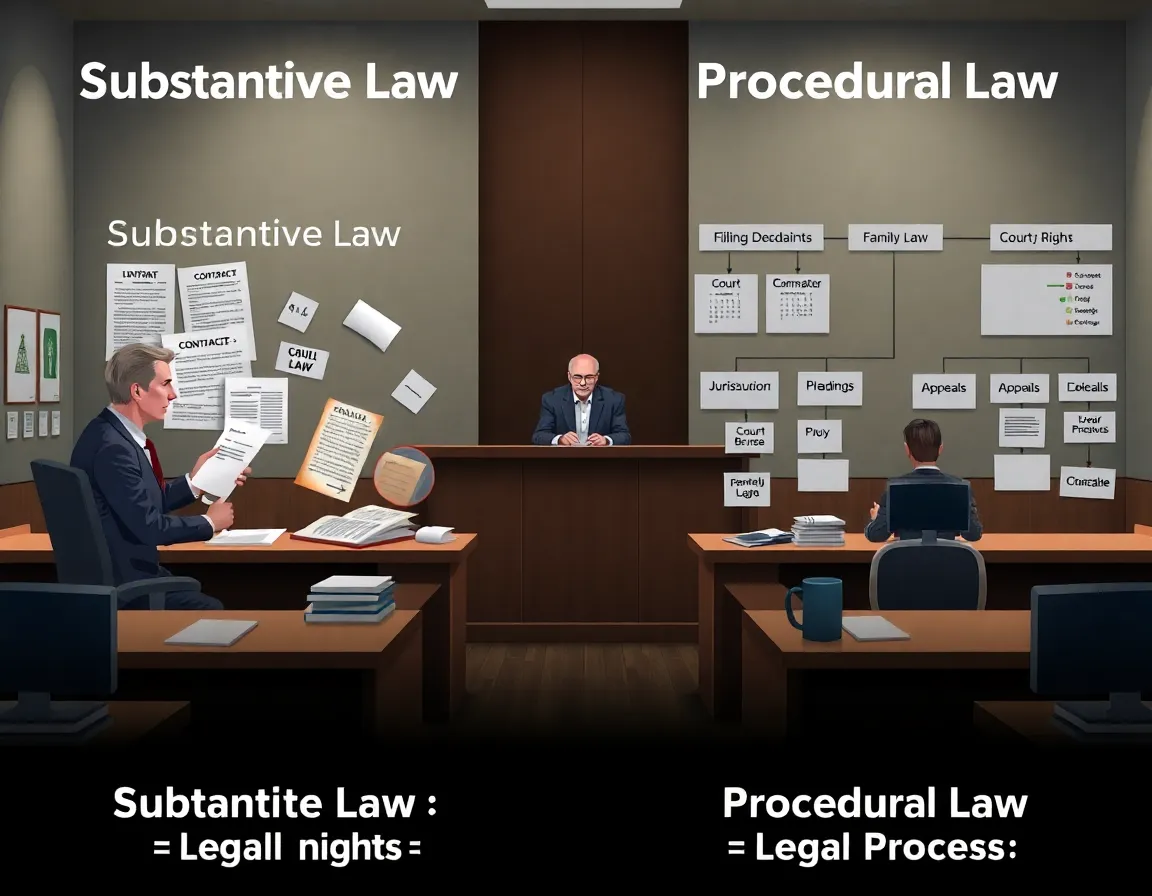Substantive vs procedural law are concepts that must be understood from a wider perspective by any individual who has the fortune or misfortune of engaging with the legal environment. While they perform different but complementary functions with regard to the administration of justice in civil proceedings, the distinction between these two branches of law will afford the interested observer one or the other insights into the judicial process-whether he be an observer, a student, a legal practitioner, or a litigant.
In civil cases, the outcome may depend not only on the determination of the rights but also on how those rights may be enforced. The distinction here becomes very pertinent. This guide explains the basic differences between them, how they function with respect to civil cases, and why they are important.
What Is Civil Procedure?
Civil procedure refers to the rules and regulations which courts observe in settling non-criminal legal disputes. These rules take care of the entire litigation process, from the moment when a claim for lawsuit is filed, service of the defendant, to hearing of pre-trial motions and discovery, trial, judgment, and appeals.
Civil procedure is about settling disputes between private parties or entities, usually involving hallmark areas such as contracts, property rights, torts, or, sometimes, family matters. Civil procedure as a whole seeks to ensure fairness, consistency, and due process regardless of the kind of dispute that is being resolved.
Substantive Law vs. Procedural Law:
Perhaps the greatest difference between substantive and procedural law is in their roles. Substantive law specifies the rights and duties of persons and the legal effect of their actions, whereas procedural law deals with the means by which rights or duties are enforced.
In civil court, both types must, in effect, work together. Substantive law might afford a person a right to damages upon the breach of a contract, whereas procedural law will dictate how the plaintiff must bring the case and prove his case. The two are inseparable when it comes to functioning.
What Does Substantive Law Cover?
Substantive Law refers to the laws directly concerned with determining the rights of parties or the remedies that may be available to a civil cause of action. It is that area of laws that creates legal relationships, duties, and rights between parties. Substantive law involves torts, contracts, property law, and family law, among others.
Using negligence as an example, the substantive law establishes the definition of negligence, the duty of care, and the damages recoverable by the plaintiff. In other words, it tells society what actions are right and wrong while telling what damages can be claimed when such acts are against the law.
What Does Procedural Law Govern?
Procedural law constitutes that which provides a method for a case to move forward. This generally includes rules about jurisdiction, statute of limitation, service of documents, admissibility of evidence, and types of appeals. The purpose of these rules is to ensure orderly and fair proceedings in the trial court. Lets understand some of the components that procedural law governs with respect to civil litigation.
- Jurisdiction determines which court is competent to hear a case.
- Pleadings rules regarding the drafting of and the filing of complaints, answers, and motions.
- Discovery rules regarding the exchange of evidence between parties.
- Trial Procedure regulates the manner in which hearings will be conducted.
- Appeals specify under what circumstances and the time an outcome can be appealed to a higher court.
What is particularly important about procedural law is the fact that even the party whose claim is fundamental may lose a case when he does not follow the requirements of a procedure. As an example, when a plaintiff fails to bring a complaint within the statute of limitations, it may then be dismissed even though it is merited as per the location of jurisdiction. Similarly, failure to submit evidence with the required deadline or to address an appeal will be disastrous to the case. This confirms the belief that the procedural law is not a mere technical process, but it has a direct effect on the consequence of civil proceedings.
Without these procedural safeguards, it would be utterly impossible – nor fair – to vindicate substantive rights consistently or fairly across different cases or jurisdictions.
How Civil Proceedings Work in Practice?
In practice, civil proceedings motion with a purpose of filing a case by the complainant himself to come up with an allegation that forms the basis of the legal action. Then serve the legal papers to the defendant followed by a reasonable allowance of time for the latter to respond. What follows forms a series that is almost entirely governed by procedural law as regards the entire process-from discovery to pre-trial motions.
But then during trial, there is much more than just an application of the substantive and procedural law; such would include laws on evidence, which proceduralize the way by which the evidence is either admissible, who can testify, and the procedures applied by the court in handling the objections raised concerning such evidence. Both substantive and procedural interact with one another to ensure that both the legal basis and method of enforcement is preserved.
Why Does Distinction Matters in Legal Cases?
Such a difference, however, affects the matters that arise in practice. The negative head will also loiter while adaptation is made in order to distinguish it from the very substantive claim. A good, substantive case rests firmly on the shoulders of procedural rules. For example, a debilitating filing deadline or missing information can sink a really great case.
This difference also has implications for appellate jurisdiction and appeals. A court of appeals, for instance, might set aside a judgment even though the substantive claims of the case were true because a procedural misstep was made in the lower court. It contributes to and help lawyers develop tighter strategies to build stronger cases along lines that best educate clients regarding their odds.
Examples of Substantive vs. Procedural Law in Civil Cases
The best way to learn the distinction is through examples that indicate how each type of law functions in real-world legal scenarios.
Substantive Law
A homeowner sues a contractor for breach of contract. The legal criteria for what constitutes a valid contract and what remedies are available fall under substantive law.
Procedural Law
The homeowner must file the complaint within the statute of limitations; they must also follow court rules for serving the contractor and filing evidence. These are procedural requirements.
If the homeowner misses a deadline (procedural issue), the court can dismiss the case-even if the contractor clearly breached the contract (a substantive issue). This illustrates why applying both branches of law is critical to justice.
Final Thoughts
Knowing the differences between substantive law vs procedural law will prove useful when managing the ramifications of civil procedure. Substantive law determines what your legal rights are; procedural law maps the way for you to assert those rights before a court. Such is an equal consideration in civil litigation.
When filing a lawsuit or defending one or in preparation for law school exams, knowing how the substantive and procedural sides of law operate in court can indeed make all the difference. The system works only when the two operate in unison, thereby guaranteeing both fairness and clarity of law in every case.





